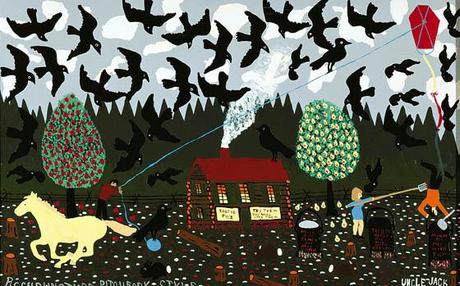
John William "Uncle Jack" Dey's Acupuncture Pitchfork Style
Amelia Cornfield was an intern in the Media and Technology Office this summer, where she worked on a variety of web and social media projects. She loves the Luce Foundation Center, and selected this painting from the folk art collection on display in the Center to write about for the blog.
People respond to works of art in different ways and not all interpretations match the artist's original intent. I recently experienced this when looking at John William "Uncle Jack" Dey's 1974 painting, Acupuncture Pitchfork Style, as I overlooked the painting's darker theme. (Hint: what is the woman on the right doing?)
When I first looked at the work, nothing contradicted my impression of an idealistic fall setting. Dey's bright, primary colors and compression of space seemed to give his painting a cartoonish feel and juvenile tone, distinguishing it from other landscapes paintings I have seen. I did not understand the relationship between the figures but, given their cheerful setting, I imagined they were playing a game with the kite. The hand-written sign advertising the pies and inviting me to "try them you will like them" reminded me of a child’s lemonade stand sign.
I did not hesitate to personalize the landscape with my memories, assuming that the scene's timelessness and unidentified location left the painting's narrative open to interpretation. The fruit on the ground took me back to apple-picking trips with my family. My mouth watered for the "exotic pies" advertised, and the steaming vats reminded me of the country stores that accompany every orchard selling homemade baked goods and hot cider.
I later discovered that I had been overzealous in accepting collector Jan Rosenak’s invitation to "make up your own story for the painting." Eager to relive my trips to apple orchards, to experience my favorite season, and to satisfy a craving for apple pie, I overlooked crucial elements of the scene. However, once I focused on the woman in the center, I noticed her red-tipped pitchfork was actually an instrument of torture. I realized that the gruesome fruits of the woman’s labor would be used in the "exotic pies" that I initially found enticing. In hindsight, I should not have been horrified by this sudden understanding because the painting's title does not disguise its dark narrative. No doubt if I were driving by this scene I would be foolish enough to stop and enter the cabin in pursuit of pie. Perhaps the orange-shirted acupuncture pitchfork victim got himself into trouble because he made exactly this mistake.

